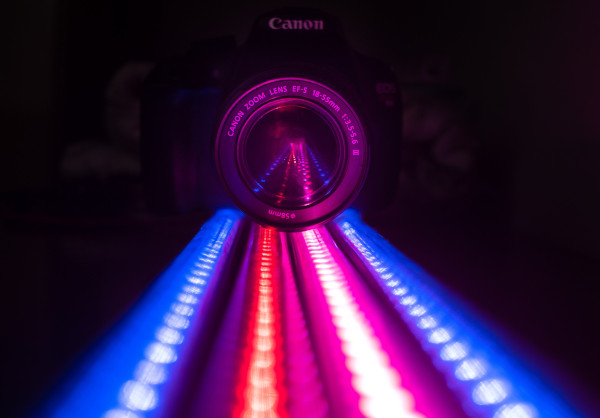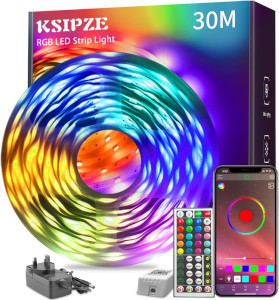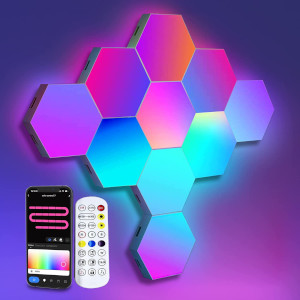10 Benefits of Energy-Saving LED Lights and Why You Need Them in Your Life
Over the last decade, more and more people are switching to LED lights. Why? Because they’re awesome and have tonnes of benefits.
Everyone knows what LED lights are, right? A form of lighting that’s designed to be highly energy-efficient and long-lasting.

But what people don’t really know is: what are the benefits of using energy-saving LED lights? How are LEDs energy-efficient? How can they save you money on your electricity bills? How can they help save the environment?
Let’s take a look.
Energy-Saving
LED lights are energy-saving due for several reasons:
- Efficient Conversion: LED lights convert a higher percentage of electrical energy into light compared to traditional lighting technologies, such as incandescent bulbs or fluorescent lamps. They minimize energy wastage as heat, resulting in more efficient use of electricity.
- Lower Power Consumption: LED lights consume significantly less power to produce the same level of brightness as traditional lighting options. For example, an LED bulb may use only 10-20% of the energy consumed by an equivalent incandescent bulb while providing comparable light output.
- Directional Lighting: LED lights emit light in a specific direction, unlike traditional bulbs that disperse light in all directions. This directional lighting reduces wasted light and ensures that the illumination is directed where it is needed, improving efficiency.
- Reduced Heat Emission: LED lights produce very little heat compared to incandescent bulbs or halogen lights, where a significant portion of the energy is wasted as heat. The minimal heat emission of LEDs means less energy is lost and less strain is placed on cooling systems, contributing to overall energy savings.
- Instant On/Off: LED lights provide instant illumination when powered on, without any warm-up time. This eliminates the need to keep lights on when they are not in use, further reducing energy consumption.
- Dimming Capability: Many LED lights are dimmable, allowing users to adjust the brightness levels according to their needs. By dimming the lights, energy usage can be further reduced when full brightness is not required.
- Efficient Light Distribution: LED lights can be designed with optical systems that distribute light more efficiently, minimizing glare and focusing light where it is needed. This precision in light distribution enhances the overall energy efficiency of LED lighting systems.
Long Lifespan
Energy-saving LED lights have a long lifespan for a number of different reasons:
- Solid-State Design: LED lights are constructed using solid-state components, meaning they do not have fragile filaments or gases that can deteriorate over time. The absence of moving parts or delicate materials makes LEDs more durable and less prone to failure.
- Efficient Energy Conversion: LED lights convert a higher percentage of electrical energy into light, minimizing energy wastage as heat. This efficient energy conversion reduces the stress on the LED components, allowing them to operate at lower temperatures and increasing their lifespan.
- Lower Heat Emission: LED lights produce significantly less heat compared to traditional lighting technologies, such as incandescent bulbs or halogen lights. Heat is a major factor that contributes to the degradation of lighting components. By generating less heat, LED lights experience less thermal stress, leading to a longer lifespan.
- Quality Materials: LED lights are manufactured using high-quality materials, including robust semiconductors and durable packaging materials. These materials are selected for their reliability and resistance to degradation, ensuring the longevity of the LED lights.
- Efficient Heat Dissipation: LED lights are designed with efficient heat dissipation mechanisms, such as heat sinks or thermal management systems. These components help dissipate any heat generated by the LEDs, preventing overheating and prolonging their lifespan.
- Low Maintenance: LED lights require minimal maintenance compared to traditional lighting options. Their long lifespan means fewer replacements are needed, reducing the hassle and cost associated with frequent bulb changes.
- Environmental Factors: LED lights are less sensitive to environmental factors that can impact their lifespan. They are not affected by frequent on/off switching or rapid voltage fluctuations, which can degrade the lifespan of other types of lights.
- Advanced Manufacturing Techniques: The manufacturing processes for LEDs have improved over time, leading to higher-quality and more reliable products. Strict quality control measures are in place to ensure consistent performance and longevity of LED lights.
- Advanced Driver Technology: LED drivers, which regulate the electrical current supplied to LEDs, have also improved. The use of efficient and reliable drivers helps maintain stable performance and extends the lifespan of LED lights.
- Reduced Vibration Sensitivity: LED lights are less sensitive to vibrations and shocks compared to traditional lighting options. This makes them suitable for applications in rugged environments or areas prone to vibrations, such as transportation or industrial settings.
Money Saving

Energy-saving LED lights will save you a ton of money for a number of reasons:
- Lower Energy Bills: Due to their energy efficiency, LED lights can help reduce electricity bills. The reduced energy consumption means less electricity is required to produce the same amount of light compared to traditional lighting technologies. Over time, these energy savings can add up, leading to substantial cost reductions.
- Long Lifespan: LED lights have an exceptionally long operational life compared to traditional bulbs. They can last up to 25 times longer than incandescent bulbs and several times longer than compact fluorescent lamps (CFLs). The longevity of LED lights means fewer replacements are needed, resulting in lower maintenance and replacement costs.
- Reduced Maintenance Costs: The extended lifespan of LED lights translates into reduced maintenance costs. With traditional lighting options, frequent bulb replacements can be costly and time-consuming, especially in large installations. LED lights require less maintenance, resulting in fewer replacements and less hassle.
- Durability: LED lights are highly durable and resistant to shocks, vibrations, and temperature fluctuations. They are built with solid-state components, making them more robust compared to fragile incandescent or fluorescent bulbs. Their durability reduces the risk of damage and the need for frequent replacements, saving both money and resources.
- Dimming Capability: Many LED lights are dimmable, allowing users to adjust the brightness levels according to their needs. By dimming the lights, energy usage can be further reduced, resulting in additional cost savings.
- Lower Replacement Costs: LED lights have a longer lifespan, reducing the frequency of replacements. This lowers the overall replacement costs associated with purchasing new bulbs or fixtures.
Reduced Environmental Impact

Using energy-saving LED lights will also help the environment. Here’s how:
- Reduced Carbon Emissions: The energy efficiency of LED lights leads to a significant reduction in carbon dioxide (CO2) emissions. According to estimates, switching to LED lighting can result in carbon savings of up to 80% compared to traditional lighting technologies.
- Lower Electricity Consumption: LED lights consume less electricity to produce the same amount of light as traditional lighting options. This reduced electricity consumption reduces the overall strain on power grids, leading to decreased demand for energy production.
- Longer Lifespan: LED lights have a significantly longer operational life compared to traditional bulbs. Their extended lifespan reduces the frequency of replacements, which in turn reduces resource consumption and waste generation. Fewer discarded bulbs contribute to lower landfill waste and environmental impact.
- Reduced Hazardous Materials: LED lights do not contain hazardous substances like mercury, which is commonly found in fluorescent lamps. Mercury poses risks to human health and the environment if not properly handled during disposal. LED lights are therefore safer to use and easier to dispose of, minimizing the potential negative impacts on ecosystems and human health.
- Lower Light Pollution: LED lights can be designed with precise light distribution, directing illumination where it is needed and minimizing light spillage or upward light. This reduces light pollution, which negatively affects wildlife, disrupts ecosystems, and obscures views of the night sky.
- Sustainable Manufacturing: The manufacturing process for LED lights has become more environmentally friendly over time. Efforts are made to reduce the use of harmful substances, optimize production efficiency, and implement sustainable practices. Additionally, the recyclability of LED lights is improving, allowing for the recovery of valuable materials and reducing the environmental impact of waste disposal.
- Instant On/Off: LED lights provide instant illumination when powered on, without any warm-up time. This allows for more efficient use of lighting, avoiding unnecessary energy consumption during start-up periods.
- Heat Emission: LED lights produce very little heat compared to traditional bulbs. This reduces the load on cooling systems, leading to energy savings in overall HVAC (heating, ventilation, and air conditioning) operations.
- Integration with Smart Systems: LED lights can be integrated into smart lighting systems, enabling advanced control and automation. This allows for optimized energy management, such as scheduling, occupancy sensing, and daylight harvesting, further reducing energy consumption and environmental impact.
Instantaneous Lighting

Due to their unique design and operating principles, LED lights provide instant illumination.
- Direct Current Operation: LED lights operate on direct current (DC) power. When you connect an LED light to a power source, it receives the required DC voltage to start emitting light immediately.
- Solid-State Technology: LED lights are built using solid-state components, which means they don’t rely on heating a filament or gas to produce light, as in incandescent or fluorescent lights. Instead, LEDs utilize a process called electroluminescence, where light is generated directly from the movement of electrons in a semiconductor material.
- Electron Movement: When a voltage is applied to the LED, electrons and electron holes within the semiconductor material recombine, releasing energy in the form of photons (light). This process happens almost instantly, allowing the LED to produce light without any warm-up time.
- Rapid On/Off Switching: LEDs can be rapidly turned on and off without any delay or impact on their performance. This characteristic makes them suitable for applications that require quick and reliable lighting, such as motion sensors or strobe lights.
- Driver Circuitry: LED lights are often connected to a driver circuit that regulates the electrical current and voltage supplied to the LEDs. The driver circuit ensures the LEDs receive the necessary power and facilitates their instantaneous lighting.
- Instant Brightness: Unlike some traditional lighting technologies that may take a few seconds to reach full brightness, LED lights achieve their full brightness almost immediately when powered on. There is no need to wait for the lights to warm up or reach their optimal operating conditions.
Durability
Energy-saving LED lights are also very durable. Why? Because…
- Solid-State Design: LED lights are constructed using solid-state components, which means they don’t have any moving parts or fragile filaments like traditional bulbs. This design makes LED lights more resistant to mechanical shocks and vibrations, reducing the risk of damage during handling, transportation, or regular use.
- Robust Semiconductor Material: LEDs use a semiconductor material, typically made of gallium nitride (GaN) or other compounds, that is highly durable and resistant to environmental factors. These materials can withstand high temperatures, humidity, and fluctuations in voltage without significant degradation or failure.
- Enhanced Heat Dissipation: LED lights are designed with efficient heat dissipation mechanisms, such as heat sinks or thermal management systems. These components help dissipate any heat generated by the LEDs, preventing overheating and prolonging their lifespan. Efficient heat dissipation also reduces the risk of damage to other components within the LED fixture.
- Resilience to Temperature Changes: LED lights can operate within a wide range of temperatures, from extreme cold to high heat, without compromising their performance or longevity. This makes them suitable for various indoor and outdoor applications, including environments with extreme temperature fluctuations.
- Resistance to Environmental Factors: LED lights are resistant to environmental factors that can impact their performance and lifespan. They are not affected by frequent on/off switching, rapid voltage fluctuations, or changes in humidity. This durability allows LED lights to maintain consistent performance over time, even in challenging conditions.
- Impact Resistance: LED lights are more resistant to impact compared to traditional bulbs. The solid-state construction and durable semiconductor material make them less prone to breakage if accidentally dropped or subjected to physical shocks. This durability is particularly advantageous in applications where lighting fixtures may be exposed to rough handling or vibration, such as in industrial or outdoor settings.
- Long Operational Life: LED lights have an exceptionally long operational life compared to traditional lighting options. Their extended lifespan reduces the need for frequent replacements, minimizing the risk of damage during maintenance or replacement procedures.
- Vibration Tolerance: LED lights are designed to withstand vibrations without compromising their performance. This quality makes them suitable for applications such as automotive lighting, where vibrations from the vehicle’s motion can be significant.
- Enhanced Sealing and Protection: LED lights can be designed with proper sealing and protection against dust, moisture, and other environmental contaminants. This feature ensures that the internal components of the LED are shielded from external elements, further enhancing their durability and reliability.
Directional Lighting
LED lights are also capable of providing directional lighting due to their unique design and optical characteristics.
Here’s how:
- LED Chip Orientation: LED lights consist of a semiconductor chip that emits light when an electric current passes through it. The chip is mounted within the LED package, and its orientation plays a significant role in determining the directionality of the light. The chip is typically positioned on a reflector or a heat sink to control the direction of the emitted light.
- Reflective Elements: LED lights often incorporate reflective elements, such as reflector cups or lenses, to control the directionality of the emitted light. These elements help direct the light in a specific beam pattern, such as narrow spot, wide flood, or asymmetric distribution.
- Optics Design: LED lights can be designed with specific optical components, such as lenses or diffusers, to manipulate the light output. These optics shape and control the light beam, allowing for precise control of the direction and distribution of light. Different optical designs can create focused, wide, or even asymmetric lighting patterns.
- Beam Angles: LED lights are available in a range of beam angles, which determine the spread of light emitted from the fixture. Narrow beam angles focus the light in a specific direction, providing more concentrated illumination. Wide beam angles disperse the light over a larger area, offering more even and diffused lighting.
- Directional Emitters: The physical structure of LED chips and their encapsulation also contribute to the directional lighting characteristics. LED chips are often designed with a lens or dome that focuses the emitted light in a particular direction. This design helps concentrate the light output and prevents excessive light dispersion.
- Optimal Light Extraction: LED lights employ techniques to maximize light extraction from the semiconductor material. For example, the LED chip may have a textured or patterned surface that redirects internally reflected light towards the desired direction. This enhances the overall efficiency and directionality of the emitted light.
- Secondary Optics: In some cases, LED lights may utilize secondary optics, such as reflectors or TIR (total internal reflection) lenses, to further control and shape the light distribution. These optics help redirect the light and minimize losses, ensuring efficient and directional lighting.
Safety

LED lights are considered safe for a number of reasons:
- Low Heat Emission: LED lights produce significantly less heat compared to traditional lighting options like incandescent bulbs. The heat generated by LEDs is minimal and localized to the semiconductor junction. This low heat emission reduces the risk of burns and fire hazards, making LED lights safer to use, especially in enclosed spaces or near heat-sensitive materials.
- Cool to the Touch: Due to their low heat emission, LED lights remain cool to the touch even after prolonged use. This characteristic reduces the risk of accidental burns or injuries when handling the lights or coming into contact with the fixtures.
- No UV Emissions: LED lights produce very minimal or no ultraviolet (UV) radiation. UV radiation can be harmful to the skin and eyes, causing various health issues. LED lights are considered safe for prolonged exposure, making them suitable for applications where people are in close proximity to the light source, such as in residential, commercial, or healthcare settings.
- No Mercury Content: Unlike some other lighting options, such as fluorescent lamps, LED lights do not contain mercury or other hazardous materials. Mercury is a toxic substance that poses risks to human health and the environment. LED lights eliminate the need for special handling or disposal procedures associated with mercury-containing bulbs, contributing to overall safety and environmental sustainability.
- Reduced Risk of Breakage: LED lights are solid-state devices that do not rely on fragile filaments or glass enclosures like incandescent bulbs. This makes LED lights more resistant to breakage, reducing the risk of injury from shattered glass or exposed filaments.
- Shock and Vibration Resistance: LED lights are designed to be more shock-resistant and tolerant to vibrations compared to traditional lighting options. The solid-state construction of LEDs makes them less susceptible to damage or failure due to physical shocks, making them safer for use in environments where vibrations or impacts may occur.
- Lower Fire Hazard: LED lights operate at low voltages, reducing the risk of electrical malfunctions and fire hazards. The low power requirements and efficient energy conversion of LED lights help minimize the strain on electrical systems, reducing the likelihood of electrical overloads or short circuits.
- Compliance with Safety Standards: LED lights undergo rigorous testing and certification processes to ensure compliance with safety standards and regulations. This includes testing for electrical safety, thermal management, and compliance with specific industry guidelines. LED lights that meet these safety standards offer peace of mind to users and are considered safe for use in various applications.
Low UV Emissions

Energy-saving LED lights have low ultraviolet emissions due to the following reasons:
- Design of Semiconductor Materials: LED lights are constructed using semiconductor materials, such as gallium nitride (GaN) or indium gallium nitride (InGaN), which have inherently low UV light emission properties. The composition and structure of these materials are carefully engineered to minimize UV radiation during the light-emitting process.
- Phosphor Conversion: White LED lights often utilize a phosphor coating to convert the blue light emitted by the LED chip into a broader spectrum, including warmer colors like yellow or white. This phosphor conversion process absorbs a portion of the UV light produced by the blue LED and re-emits it as visible light, further reducing UV emissions.
- Wavelength Control: LED manufacturers carefully control the wavelengths produced by the LED chip to minimize UV output. By precisely engineering the semiconductor materials and chip design, LED lights can optimize light output in the visible spectrum while minimizing UV radiation.
- Optical Filters: In certain applications where UV emissions need to be strictly controlled, LED lights may incorporate optical filters or coatings to further reduce any residual UV radiation. These filters selectively block or absorb UV wavelengths, ensuring that the emitted light is predominantly in the visible spectrum.
- Quality Control and Testing: LED manufacturers subject their products to rigorous quality control processes and testing to ensure compliance with safety standards and regulations. This includes measuring and verifying UV emissions to ensure that they fall within acceptable limits.
It is important to note that while LED lights have low UV emissions, they may still produce a small amount of UV light.
However, the level of UV radiation emitted by LED lights is typically well below the threshold that would cause harm to human health or materials.
Nevertheless, it is recommended to follow standard safety practices and avoid prolonged exposure to LED lights at close distances, particularly in applications where UV-sensitive materials or individuals with photosensitivity are involved.
Smart Lighting Integration
LED lights can be integrated with smart lighting systems to enable advanced control, automation, and enhanced functionality.

Here’s how:
- Wireless Connectivity: LED lights can be equipped with wireless connectivity options such as Wi-Fi, Bluetooth, or Zigbee, allowing them to communicate with a central control system or smart devices. This connectivity enables remote control and automation of the LED lights.
- Smart Lighting Hubs or Gateways: Smart lighting systems often utilize a central hub or gateway that acts as a control center for all connected LED lights. The hub facilitates communication between the smart devices, sensors, and LED lights, enabling centralized control and coordination.
- Smartphone or Tablet Control: LED lights integrated with smart lighting systems can be controlled using smartphone or tablet applications. These apps provide intuitive interfaces for adjusting brightness, color temperature, and other lighting parameters. Users can also create custom lighting scenes or schedules based on their preferences.
- Voice Control: LED lights can be connected to voice-controlled smart assistants such as Amazon Alexa or Google Assistant. This allows users to control the lights using voice commands, making it convenient and hands-free.
- Motion and Occupancy Sensors: LED lights can be paired with motion or occupancy sensors to automatically turn on or off based on detected movement or presence in a room or area. This feature enhances energy efficiency and provides convenience by eliminating the need for manual switching.
- Daylight Harvesting: Smart lighting systems can integrate with daylight sensors to adjust the brightness of LED lights based on the available natural light. This feature, known as daylight harvesting, helps optimize energy usage by automatically dimming or turning off the lights when sufficient daylight is present.
- Integration with Other Smart Devices: LED lights can be integrated with other smart devices or systems within a smart home or building. For example, they can be synchronized with smart thermostats, security systems, or entertainment systems to create coordinated experiences or automation scenarios.
- Remote Access and Monitoring: Smart lighting systems allow users to access and control their LED lights remotely. This means you can control your lights even when you’re away from home, providing added security and convenience.
- Energy Monitoring and Analytics: Some smart lighting systems provide energy monitoring and analytics features, allowing users to track their energy consumption and make informed decisions to optimize energy efficiency. This information helps identify energy-saving opportunities and reduce energy waste.
- Integration with Smart Algorithms: LED lights integrated with smart lighting systems can leverage advanced algorithms to optimize lighting based on user preferences, occupancy patterns, or time of day. This adaptive lighting feature enhances user comfort and maximizes energy efficiency.
Energy-Saving LED Lights: Our Recommendation
So what do we recommend for LED lights?
For LED Strip Lights, we recommend:
Check out KSIPZE 30m Led Strip Lights on Amazon
Check PriceIf you click this link and make a purchase, we earn a commission at no additional cost to you.
These bad boys are so cool. You can:
- Hook them up to your smart device via an app and Bluetooth
- Have multi-colours
- Can control the colours from your smart app
- Are A++ rated energy efficient
- Can be controlled by music
For something a little bit more special, we recommend these LED Hexagon Lights:
Check out these awesome LED Hexagon Lights on Amazon
Check PriceIf you click this link and make a purchase, we earn a commission at no additional cost to you.
Energy-Saving LED Lights: The Conclusion
As you can see from the information above, there are plenty of reasons to switch from regular lights to energy-saving LED lights.
Whether it be saving money on utility bills, cool features, or even being more environmentally friendly – there are very few drawbacks.
So what’re you waiting for?


